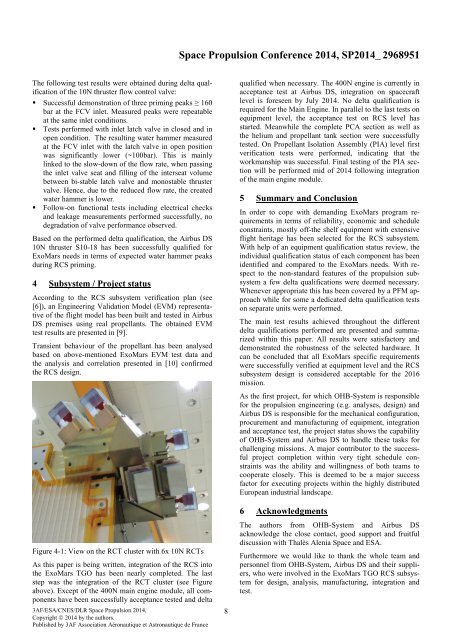1uWFeBO
1uWFeBO
1uWFeBO
You also want an ePaper? Increase the reach of your titles
YUMPU automatically turns print PDFs into web optimized ePapers that Google loves.
Space Propulsion Conference 2014, SP2014_ 2968951<br />
The following test results were obtained during delta qualification<br />
of the 10N thruster flow control valve:<br />
• Successful demonstration of three priming peaks ≥ 160<br />
bar at the FCV inlet. Measured peaks were repeatable<br />
at the same inlet conditions.<br />
• Tests performed with inlet latch valve in closed and in<br />
open condition. The resulting water hammer measured<br />
at the FCV inlet with the latch valve in open position<br />
was significantly lower (~100bar). This is mainly<br />
linked to the slow-down of the flow rate, when passing<br />
the inlet valve seat and filling of the interseat volume<br />
between bi-stable latch valve and monostable thruster<br />
valve. Hence, due to the reduced flow rate, the created<br />
water hammer is lower.<br />
• Follow-on functional tests including electrical checks<br />
and leakage measurements performed successfully, no<br />
degradation of valve performance observed.<br />
Based on the performed delta qualification, the Airbus DS<br />
10N thruster S10-18 has been successfully qualified for<br />
ExoMars needs in terms of expected water hammer peaks<br />
during RCS priming.<br />
4 Subsystem / Project status<br />
According to the RCS subsystem verification plan (see<br />
[6]), an Engineering Validation Model (EVM) representative<br />
of the flight model has been built and tested in Airbus<br />
DS premises using real propellants. The obtained EVM<br />
test results are presented in [9].<br />
Transient behaviour of the propellant has been analysed<br />
based on above-mentioned ExoMars EVM test data and<br />
the analysis and correlation presented in [10] confirmed<br />
the RCS design.<br />
qualified when necessary. The 400N engine is currently in<br />
acceptance test at Airbus DS, integration on spacecraft<br />
level is foreseen by July 2014. No delta qualification is<br />
required for the Main Engine. In parallel to the last tests on<br />
equipment level, the acceptance test on RCS level has<br />
started. Meanwhile the complete PCA section as well as<br />
the helium and propellant tank section were successfully<br />
tested. On Propellant Isolation Assembly (PIA) level first<br />
verification tests were performed, indicating that the<br />
workmanship was successful. Final testing of the PIA section<br />
will be performed mid of 2014 following integration<br />
of the main engine module.<br />
5 Summary and Conclusion<br />
In order to cope with demanding ExoMars program requirements<br />
in terms of reliability, economic and schedule<br />
constraints, mostly off-the shelf equipment with extensive<br />
flight heritage has been selected for the RCS subsystem.<br />
With help of an equipment qualification status review, the<br />
individual qualification status of each component has been<br />
identified and compared to the ExoMars needs. With respect<br />
to the non-standard features of the propulsion subsystem<br />
a few delta qualifications were deemed necessary.<br />
Whenever appropriate this has been covered by a PFM approach<br />
while for some a dedicated delta qualification tests<br />
on separate units were performed.<br />
The main test results achieved throughout the different<br />
delta qualifications performed are presented and summarized<br />
within this paper. All results were satisfactory and<br />
demonstrated the robustness of the selected hardware. It<br />
can be concluded that all ExoMars specific requirements<br />
were successfully verified at equipment level and the RCS<br />
subsystem design is considered acceptable for the 2016<br />
mission.<br />
Figure 4-1: View on the RCT cluster with 6x 10N RCTs<br />
As this paper is being written, integration of the RCS into<br />
the ExoMars TGO has been nearly completed. The last<br />
step was the integration of the RCT cluster (see Figure<br />
above). Except of the 400N main engine module, all components<br />
have been successfully acceptance tested and delta<br />
3AF/ESA/CNES/DLR Space Propulsion 2014,<br />
Copyright © 2014 by the authors.<br />
Published by 3AF Association Aéronautique et Astronautique de France<br />
8<br />
As the first project, for which OHB-System is responsible<br />
for the propulsion engineering (e.g. analyses, design) and<br />
Airbus DS is responsible for the mechanical configuration,<br />
procurement and manufacturing of equipment, integration<br />
and acceptance test, the project status shows the capability<br />
of OHB-System and Airbus DS to handle these tasks for<br />
challenging missions. A major contributor to the successful<br />
project completion within very tight schedule constraints<br />
was the ability and willingness of both teams to<br />
cooperate closely. This is deemed to be a major success<br />
factor for executing projects within the highly distributed<br />
European industrial landscape.<br />
6 Acknowledgments<br />
The authors from OHB-System and Airbus DS<br />
acknowledge the close contact, good support and fruitful<br />
discussion with Thalès Alenia Space and ESA.<br />
Furthermore we would like to thank the whole team and<br />
personnel from OHB-System, Airbus DS and their suppliers,<br />
who were involved in the ExoMars TGO RCS subsystem<br />
for design, analysis, manufacturing, integration and<br />
test.


